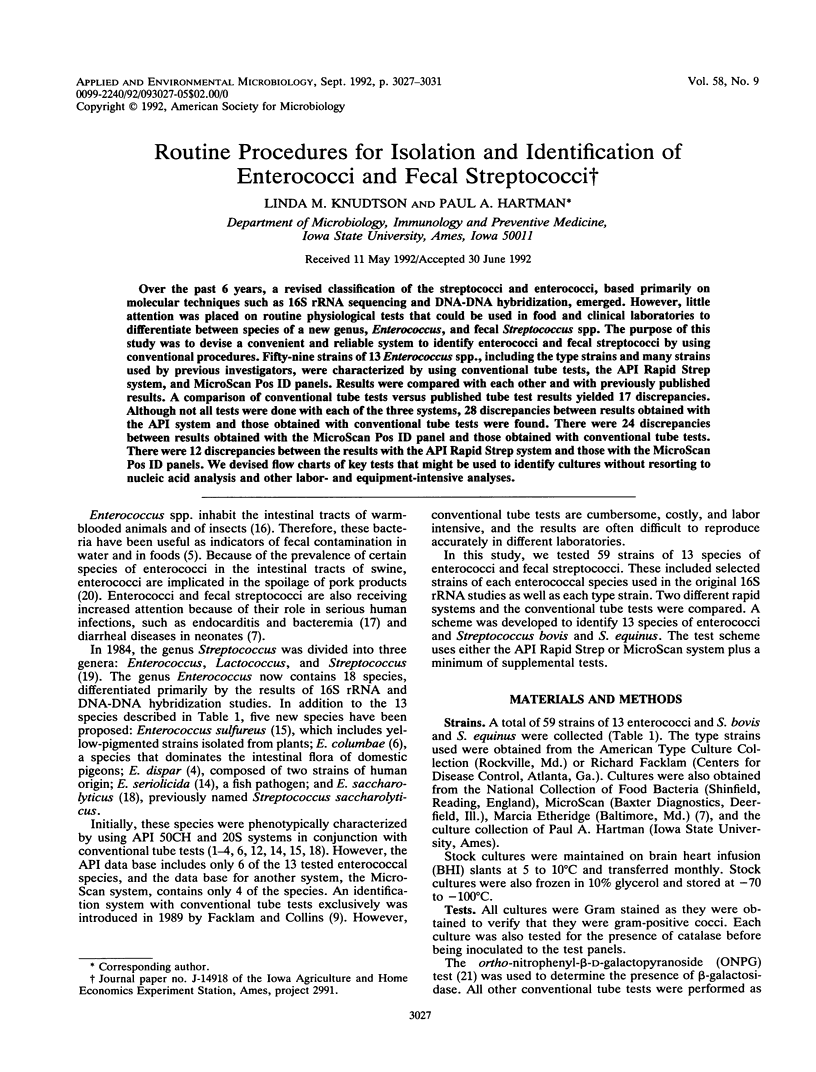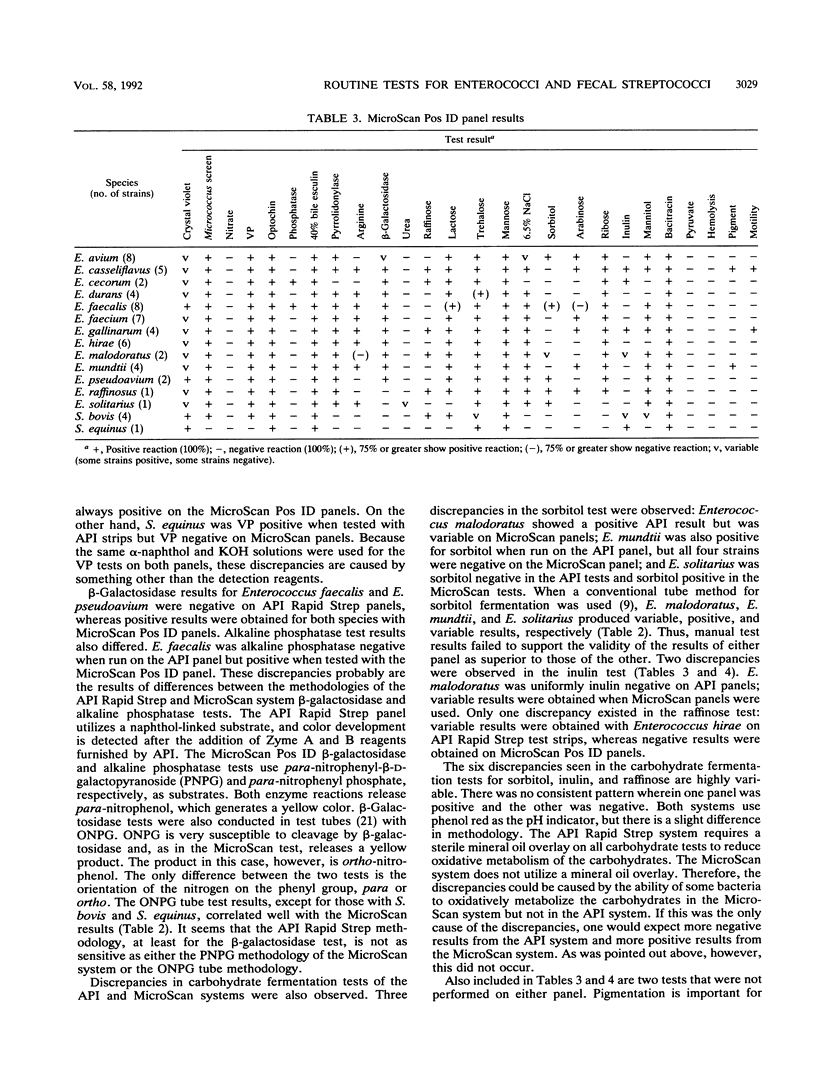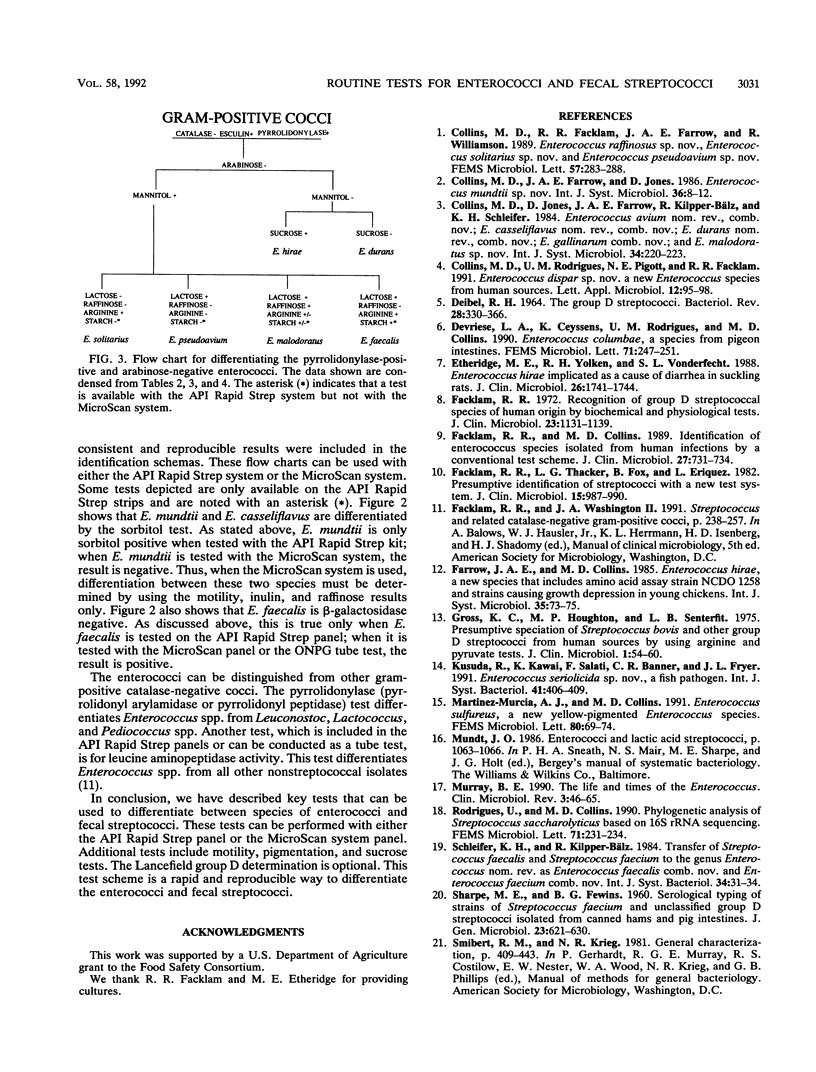Abstract
Over the past 6 years, a revised classification of the streptococci and enterococci, based primarily on molecular techniques such as 16S rRNA sequencing and DNA-DNA hybridization, emerged. However, little attention was placed on routine physiological tests that could be used in food and clinical laboratories to differentiate between species of a new genus, Enterococcus, and fecal Streptococcus spp. The purpose of this study was to devise a convenient and reliable system to identify enterococci and fecal streptococci by using conventional procedures. Fifty-nine strains of 13 Enterococcus spp., including the type strains and many strains used by previous investigators, were characterized by using conventional tube tests, the API Rapid Strep system, and MicroScan Pos ID panels. Results were compared with each other and with previously published results. A comparison of conventional tube tests versus published tube test results yielded 17 discrepancies. Although not all tests were done with each of the three systems, 28 discrepancies between results obtained with the API system and those obtained with conventional tube tests were found. There were 24 discrepancies between results obtained with the MicroScan Pos ID panel and those obtained with conventional tube tests. There were 12 discrepancies between the results with the API Rapid Strep system and those with the MicroScan Pos ID panels. We devised flow charts of key tests that might be used to identify cultures without resorting to nucleic acid analysis and other labor- and equipment-intensive analyses.
Full text
PDF




Selected References
These references are in PubMed. This may not be the complete list of references from this article.
- Collins M. D., Facklam R. R., Farrow J. A., Williamson R. Enterococcus raffinosus sp. nov., Enterococcus solitarius sp. nov. and Enterococcus pseudoavium sp. nov. FEMS Microbiol Lett. 1989 Feb;57(3):283–288. doi: 10.1016/0378-1097(89)90315-7. [DOI] [PubMed] [Google Scholar]
- Collins M. D., Rodrigues U. M., Pigott N. E., Facklam R. R. Enterococcus dispar sp. nov. a new Enterococcus species from human sources. Lett Appl Microbiol. 1991 Mar;12(3):95–98. doi: 10.1111/j.1472-765x.1991.tb00514.x. [DOI] [PubMed] [Google Scholar]
- DEIBEL R. H. THE GROUP D STREPTOCOCCI. Bacteriol Rev. 1964 Sep;28:330–366. doi: 10.1128/br.28.3.330-366.1964. [DOI] [PMC free article] [PubMed] [Google Scholar]
- Devriese L. A., Ceyssens K., Rodrigues U. M., Collins M. D. Enterococcus columbae, a species from pigeon intestines. FEMS Microbiol Lett. 1990 Sep 15;59(3):247–251. doi: 10.1016/0378-1097(90)90228-i. [DOI] [PubMed] [Google Scholar]
- Etheridge M. E., Yolken R. H., Vonderfecht S. L. Enterococcus hirae implicated as a cause of diarrhea in suckling rats. J Clin Microbiol. 1988 Sep;26(9):1741–1744. doi: 10.1128/jcm.26.9.1741-1744.1988. [DOI] [PMC free article] [PubMed] [Google Scholar]
- Facklam R. R., Collins M. D. Identification of Enterococcus species isolated from human infections by a conventional test scheme. J Clin Microbiol. 1989 Apr;27(4):731–734. doi: 10.1128/jcm.27.4.731-734.1989. [DOI] [PMC free article] [PubMed] [Google Scholar]
- Facklam R. R. Recognition of group D streptococcal species of human origin by biochemical and physiological tests. Appl Microbiol. 1972 Jun;23(6):1131–1139. doi: 10.1128/am.23.6.1131-1139.1972. [DOI] [PMC free article] [PubMed] [Google Scholar]
- Facklam R. R., Thacker L. G., Fox B., Eriquez L. Presumptive identification of streptococci with a new test system. J Clin Microbiol. 1982 Jun;15(6):987–990. doi: 10.1128/jcm.15.6.987-990.1982. [DOI] [PMC free article] [PubMed] [Google Scholar]
- Gross K. C., Houghton M. P., Senterfit L. B. Presumptive speciation of Streptococcus bovis and other group D streptococci from human sources by using arginine and pyruvate tests. J Clin Microbiol. 1975 Jan;1(1):54–60. doi: 10.1128/jcm.1.1.54-60.1975. [DOI] [PMC free article] [PubMed] [Google Scholar]
- Kusuda R., Kawai K., Salati F., Banner C. R., Fryer J. L. Enterococcus seriolicida sp. nov., a fish pathogen. Int J Syst Bacteriol. 1991 Jul;41(3):406–409. doi: 10.1099/00207713-41-3-406. [DOI] [PubMed] [Google Scholar]
- Martinez-Murcia A. J., Collins M. D. Enterococcus sulfureus, a new yellow-pigmented Enterococcus species. FEMS Microbiol Lett. 1991 May 1;64(1):69–74. doi: 10.1016/0378-1097(91)90211-r. [DOI] [PubMed] [Google Scholar]
- Murray B. E. The life and times of the Enterococcus. Clin Microbiol Rev. 1990 Jan;3(1):46–65. doi: 10.1128/cmr.3.1.46. [DOI] [PMC free article] [PubMed] [Google Scholar]
- Rodrigues U., Collins M. D. Phylogenetic analysis of Streptococcus saccharolyticus based on 16S rRNA sequencing. FEMS Microbiol Lett. 1990 Sep 1;59(1-2):231–234. doi: 10.1016/0378-1097(90)90062-u. [DOI] [PubMed] [Google Scholar]


